If a nuclear bomb were to hit, the blast would create a massive fireball, which would vaporize everything nearby. The fireball would shoot miles into the atmosphere – pulling dirt and debris with it. The radioactive debris then falls back to the earth, contaminating everything it touches.stu
This is known as fallout. You’d need to immediately get in a fallout shelter to avoid getting poisoned.
Wind and rain can cause fallout to spread far away from the blast site. This “delayed fallout” could cause radioactive particles to fall all over the earth, so knowing where a fallout shelter is is essential, even if you don’t live near a potential target.
While you hopefully never will need this information, it can’t hurt to know where fallout shelters are located nearby and what to do if a nuclear alert goes off.
What Are Fallout Shelters?
Contrary to what some people think, a fallout shelter is not the same as a bomb shelter. It is not meant to help you survive the destruction from a nuclear bomb.
Even if you had enough warning to get to a bomb shelter, experts generally agree that a nuclear bomb would vaporize everything within 0.3 miles of Ground Zero.
Instead, the purpose of a fallout shelter is to protect you from the radioactive particles falling from the sky. You can avoid the lethal fallout levels immediately after the blast by getting into a shelter quickly.
Tip: Check out the NukeMap tool. It lets you map a nuclear bomb’s blast area and fallout distance and even enables you to change wind direction to see how far the fallout would blow.
What Makes a Good Fallout Shelter?
Fallout shelters need to be made from thick layers of dense material. The more material you have between you and the fallout, the more protection you will have. This is why many fallout shelters are built in basements or abandoned mines: the layers of dirt provide natural protection against fallout.
How well a shelter protects against fallout is measured as the Protective Factor (PF). Think of it like SPF but for fallout. In a shelter with a PF of 200, you would receive 1/200th of the dose you would have received in the open.
How Quickly Do You Need to Get Inside a Fallout Shelter?
You have only about 10 to 15 minutes to get to the shelter before massive amounts of toxic fallout fall to earth. According to the Johns Hopkins Center for Health Security, these minutes are critical to survival.
The sooner you get inside, the less likely you are to be lethally poisoned or get cancer later down the line.
Tip: Put emergency alerts on your phone
You can set up your phone to get alerts about disasters like nuclear blasts, hurricanes, tornadoes, etc. Read about how here. I also recommend getting an emergency NOAA radio with an alert feature.
Immediate Shelter vs. Evacuating
Federal guidelines (from multiple countries) say you should take immediate shelter in whatever adequate shelter is nearby – even if the shelter doesn’t provide the best protection. An “adequate” shelter would be a shallow basement, the top floor of an office building, or another structure with a PF of at least 10.
The reasoning is this: it is better to stay in an adequate shelter than risk going out into the radioactive fallout at its worst.
Remember that roads get blocked, and traffic gets insane during emergencies. Even if the fallout shelter is only a “short” drive away, you might not make it in time.
You should only evacuate if your current shelter is completely inadequate, such as a mobile home or a wood home without a basement. In these situations, it could be worth the short-term exposure for the long-term protection of a better fallout shelter.
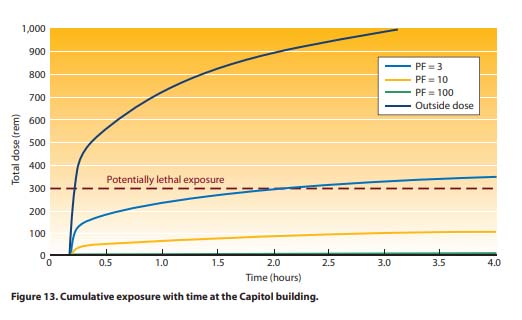
As you can see from the chart above, spending any amount of time outdoors in the first 30 minutes after a blast could create a lethal dose of radiation. If you have adequate shelter, it’s better to stay put!
How Long Do You Need to Stay Inside a Fallout Shelter?
Because radiation decays rapidly, the potential for radiation exposure decreases by 55% an hour after the explosion and 80% after 24 hours. This is why Ready.gov says to shelter for at least 24 hours after a nuclear blast. Ideally, you would shelter even longer.
Remember to have emergency supplies stockpiled in your shelter and packed bug-out bags so you have everything you need.
Are There Public Fallout Shelters in the USA?
In the 1960s, the United States had a national fallout shelter program run by the Federal Civil Defense Administration. It created and stocked fallout shelters throughout the country. As a result, you can find many fallout shelters throughout the nation.
They are often in the basement of public buildings like movie theaters, banks, or universities. Many residential apartment buildings built during the 1950s and 60s have fallout shelters, too.
By the 1970s, funding for this program dried up. The fallout shelters mostly went into neglect or were repurposed for something else – like all those NYC fallout shelters that are now used as laundry rooms.
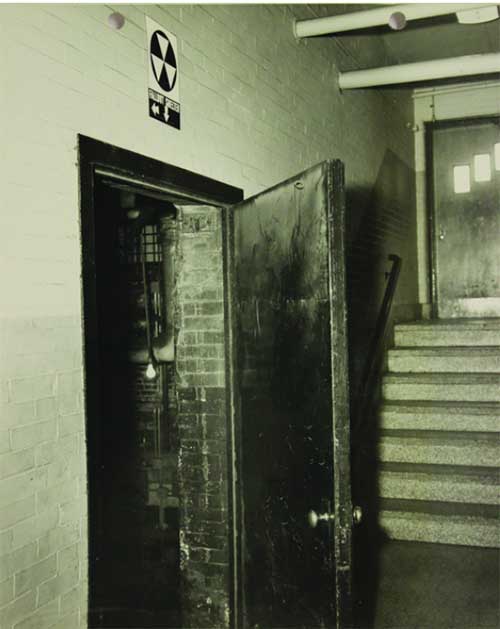
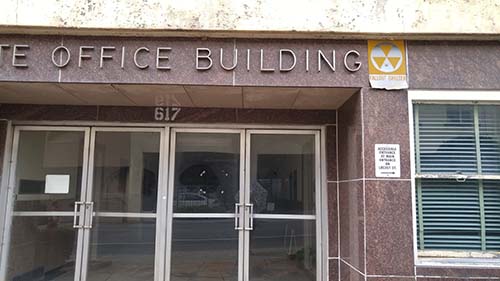
Note: Many of these public fallout shelters were not specifically built as such. Instead, they are buildings with thick walls or basements deemed deep enough to protect from the fallout. Your basement might provide better protection!
Fallout Shelters Maps
Below are links to maps of public fallout shelters in the USA. But don’t assume you’ll be able to use these shelters, though, as most have been completely neglected. Some of the shelters might even be sealed shut. Others might be impossible to access during an emergency, such as military bunkers, which are guarded.
The bottom line? You must go and check out the fallout shelters on the map yourself! Don’t just assume they are still there.
- New York City Fallout Shelters
- Washington DC Fallout Shelters
- Detroit Fallout Shelters
- Milwaukee Fallout Shelters
- Georgia Fallout Shelters
- La Crosse County, Wisconsin Shelters
Also, check out the Civil Defense Museum’s Collection of Community Shelter Plans. This collection has old maps showing where fallout shelters were in the 1950s and 60s. They have plans for many places in Texas, Baltimore, Massachusetts, and more. Many shelters are likely discontinued, but you might also be surprised to learn that there is a fallout shelter near your home.
You can also go to Ready.gov Shelters to search for shelters. Most of these are not for fallout but shelters for natural disasters like hurricanes. However, since a natural disaster is much more likely than a nuclear attack, it’s good to know where these shelters are located too.
The Downside of Public Fallout Shelters
One of the problems with public fallout shelters is that anyone could come in. Let’s assume you can get to the shelter within 10 minutes, meaning you’ve escaped the worst of the radiation.
But then, an hour later, someone else comes to the fallout shelter.
Opening the door exposes you to radioactive fallout, not to mention all of the fallout on the person’s clothing and body. You might not be able to keep that person out (assuming the door even locks; good luck convincing other people in the shelter not to let the person in!).
Thus, it might make more sense to shelter in your basement than rush to a “better” fallout shelter in the next-door public building.
What If You Can’t Find a Fallout Shelter Near You?
Since it’s improbable that you have a fallout shelter nearby enough to be helpful, you should know other safe places. You want to find sites with thick, dense materials around them. These materials do best at shielding from radioactive fallout. Here are some options.
1. Basement or Crawlspace of Your Home
Going into the basement is probably your best choice if a nuclear blast occurs while you are home. As mentioned before, it is better to take adequate shelter than risk high exposure by trying to get to a better fallout shelter located halfway across town.
While basements alone don’t provide much shielding against fallout, there are simple things you can do to increase protection — like building walls out of sandbags and staying behind them. The sandbag would absorb some of the fallout.
2. Large Office Buildings
Because large buildings are usually made with lots of concrete and steel, they can provide excellent shielding against fallout. The basement is the best choice, but an interior room can also provide protection. Other large buildings, such as shopping malls, can also provide protection.
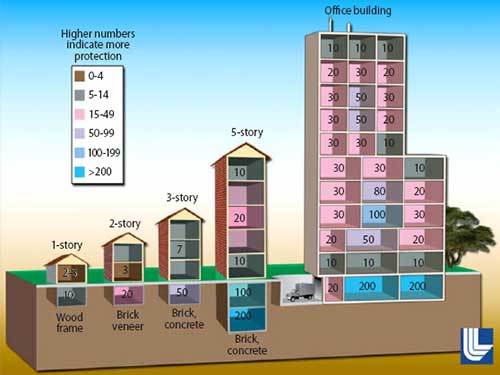
Image Source: Key Response Planning Factors for the Aftermath of Nuclear Terrorism (PDF), CC BY-NC-SA 4.0
3. Underground Parking Garages
Try to get to the lowest level and the most interior part of the parking garage. One study found that the -1 level of parking garages had PFs ranging from 491 to 794. At the -4 level, the protection was up to 6,397.
4. Mines and Caves
Going 3 feet underground will give you a protection factor of 5,000. The actual PF would likely be less because of open entrances, but mines and caves still provide excellent protection against fallout.
However, the problem with relying on a mine or cave as a fallout shelter is that it’s doubtful you’d be able to get to them fast enough. As mentioned before, it’s usually better to stay in a less protective shelter (like your basement) than risk exposure trying to get to a cave or mine. Plus, don’t be surprised if other people have the same idea and it is crowded with contaminated people!
5. Subway Tunnels
Because they are underground, subway tunnels can protect against fallout. They often have PFs greater than 100. The PF would be higher if it weren’t for ventilation and entranceways found throughout the system.
You could increase protection by going deeper into the subway system, far away from entrances (and new people entering with contaminated clothing and skin). Assuming it wasn’t destroyed by EMP, having a flashlight in your EDC would be useful for getting you deeper into the tunnels.
6. Underground Tourist Attractions
Many places have tunnels, caves, catacombs, and other underground tourist attractions. These could provide excellent protection against fallout, assuming you could make it there in time.
7. Abandoned Underground Locations in Cities
Do a Google search for “urban exploring underground city name.” You’ll find some cool places that could work as fallout shelters.
Like abandoned subway concourses in Philadelphia. Or the hidden tunnels under San Francisco. Or catacombs in graveyards that you can sneak into.
Unlike touristy sites, these underground attractions are less likely to be crowded after a nuclear disaster. You might have to hop a fence or two to gain access, but you could have the place to yourself – thus reducing contact with people covered in fallout.
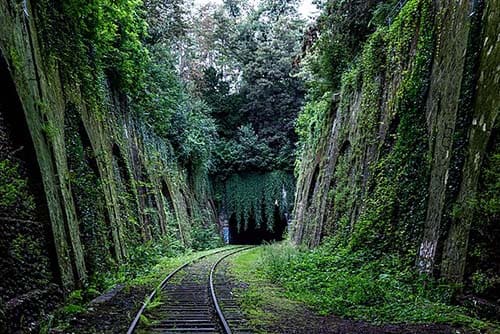
Building Your Own Fallout Shelter
Because you need to take shelter immediately after a nuclear blast, having your own fallout shelter at home would be the best option. There are many ways to build one without spending a fortune – such as reinforcing walls in your basement or making a root cellar.
For starters, I recommend checking out the guide by Eugene P. Wigner – a physicist, Nobel Laureate, and “only surviving initiator of the nuclear age.” The guide was last updated in 1987 but still has some good info about building materials and ventilation. You can read the free PDF here.
And while the threat of nuclear war may be terrifying, don’t forget to prioritize your prepping needs! First, focus on emergency food, water, and other essential supplies. Only then should you worry about your nuclear fallout shelter and nuclear survival kit.
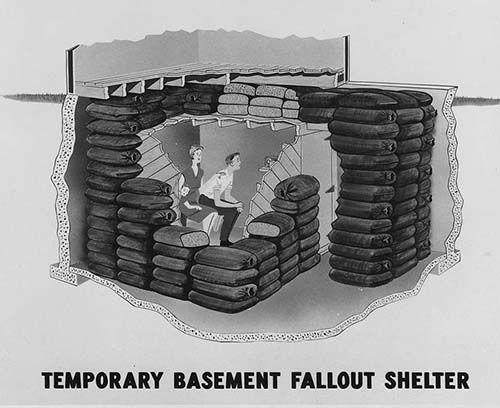
https://urbantimesonline.com/2020/03/16/fallout-shelters-had-their-day-in-cold-war-era/
https://remm.hhs.gov/IND_ResponsePlanning_LLNL-TR-410067.pdf
https://www.vice.com/en/article/nz8jpg/how-to-survive-the-first-hour-of-a-nuclear-attack
https://www.britannica.com/technology/nuclear-weapon/Residual-radiation-and-fallout


form a civil project in your neighborhood where everyone who wants to have shelter chips in to build a shelter. either money, material, or labor. and do it quickly. You only have maybe till January.
I read that quite a few shelters are in disrepair. How would we know which ones to go to.
no one would be happy in a fallout shelter>bad hygene, angry, scared ppl, burns and blindness, im more for private shelter, start digging and make a solid shelter with a concrete wheel on a door…
there’s a fallout shelter in maryland langley park next to my house
i have pictures
I live in St Paul, Mn suburbs and there are no shelters that I can find….Any ideas????
You could make a shelter in a basement or crawlspace. But I would first make sure you have all your other preps taken care of first — like making sure you are ready for a long-term power outage or blizzard — before you build yourself a shelter!
Military base no matter if its retired or not are primary targets. You never want to go there it will ne ground zero.
More likely infrastructure: hospitals, CDC, Power plants, Nuclear facilities, Manufacturing hubs and major intersections…They’ll wait for troops to engage on site and hit those locations again or as well, once engaged. Complete destruction…they learned from the best…US…USA…worlds greatest terrorists. We reap what we sew.
Just watched a documentery called and we die.Government has all kinds of survival places but were not welcome
Called “And we die”? I couldn’t find it with a quick google search. Where can you watch it?
I think it’s called, “While the Rest of Us Die”.
It’s a documentary based on the Raven Rock Complex
https://en.m.wikipedia.org/wiki/While_the_Rest_of_Us_Die:_Secrets_of_America%27s_Shadow_Government
Try YouTube maybe??
Its on Tubi
Yep. Selected “few” will be warned ahead of time, and some, most likely, already know their assignment at this very moment. Those gov official shelters most likely already have assignments and specific purpose when SHTF happens. So, if you are not on the white list, then… well, this situation was played in many movies. Everyone on their own, so plan ahead if this concerns you. Most people think it will never happen, but when it does, it’s them first will go berserk, because they would not have any alternatives or plans.
Is anyone watching these places? It would be nice to know when people start moving into them or when supplies are being brought to them so that the rest of us have a clue that something is up!
Many “former” military bases are still owned by government agencies and/or military to this day. If we needed them these would be guarded by mp and admittance would be denied simply because the military still owned it and might need to reopen the base
I’m 4 miles from a primary target, I’m guessing I’d be vaporized if there were a nuclear attack 🙁
Absolutely! One thing never really discusses is some primary targets have 20+ warheads assigned.
You should move away from that area
That might be a good thing. I’m not sure I would want to survive. There would probably be a lot of bad things to follow.
Definitely so! Looting, stealing,murder….many many people will be in personal survival mode.
You and me both 🙁
One place not mentioned, former military bases. I retired from a nearby base. I know where the fallout shelters are. They are my primary resource for this disaster.
Would that be places like Camp Dunlap, Ca “Slab City”, Ft. Ord, El Toro, Salton City, March AFB Riverside, Ca
I’m in SW Kansas the closest to me are near Kansas City
Where in Kansas city, please. I live in overland park and can’t find anything on the map.
sabrina dont fear to much got a place you can go in Missouri not to far from you
Hi, how about South Kansas, City near swope park zoo.
I’m close to Perris but it might. Be a target would it be safe ?
I live near Salt Lake City, UT, would there be any near.
hey rick fort ord is longer there it was taken down the only thing there as i was told belongs to the presidio of Monterey government buildings for the navy and they are not going to let you in as i was told
I just watched Glenn Beck special “How to prepare for the HORRIFYING Reality of a Nuclear Bomb”. It got me to searching and thinking about the real possibility. It truly is HORRIFYING and there is Alot to think about. I found this web site information. Thank you!
OMG, me too. I have Blaze subscription and finally got around to watching his special. Scary times. Pray and pray often.
Please tell me what Blaze is. I saw a sign for a fallout shelter and started doing some research. This is terrifying!
I know right
It is scary